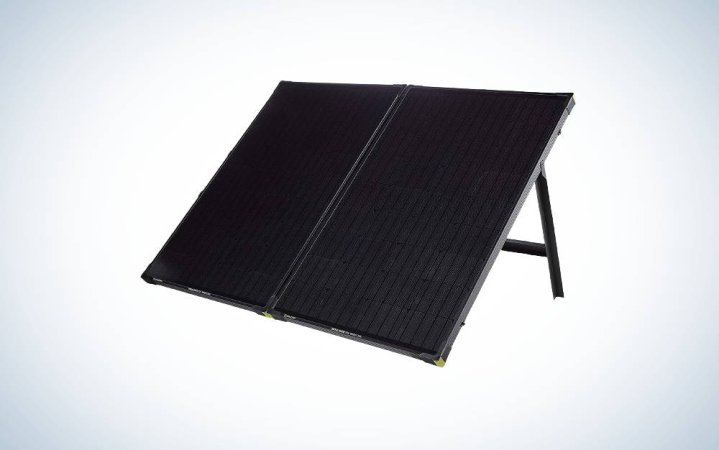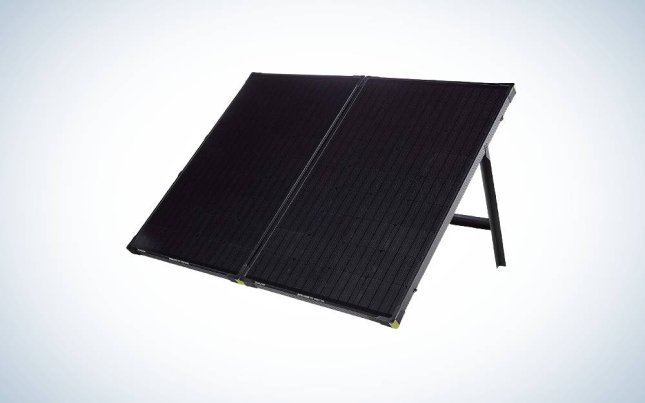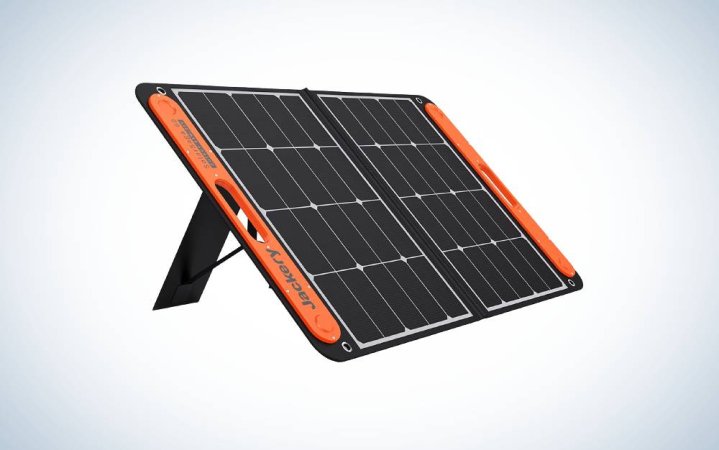We may earn revenue from the products available on this page and participate in affiliate programs. Learn more ›

Hydro, wind, geothermal, and solar panels all represent the future of renewable energy. But why wait for everyone else to figure out the benefits when you can take the initiative to start relying on renewable energy today? Whether you are looking to completely power a home, generate power for an RV, or just charge your phone at the campsite, have the best solar panels are an excellent choice.
The best solar panels are typically made with monocrystalline silicon wafers. Their high efficiency and power output make them ideal for powering a home. However, polycrystalline and thin film solar panels are also effective choices that are more affordable. To get a better understanding of the various products available, take a look at this list of top products, then keep reading for detailed information on solar panel types, size, weight, and device integration to help you find the best solar panels for long-lasting renewable energy.
- Best overall: HQST Solar Panel 2pcs 100 Watt 12V Monocrystalline
- Best for the money: Nekteck 21W Solar Charger
- Best for camping: Goal Zero Boulder 200 Watt Briefcase
- Best portable: Jackery SolarSaga 60W Solar Panel
- Best for RVs: Renogy 200 Watt Monocrystalline
How we chose the best solar panels
Having used solar panels to power camp stoves, mobile devices, and power stations for many camping trips, this first-hand experience helped to found the basis for the selection criteria, though extension research was also required in order to choose the best products from over 30 different panels. The top choices were selected based on the type of solar panel, the size and weight of each product, as well as the suitability of the solar panel for various uses, like powering solar generators, hiking, camping, or heading out in the RV.
Monocrystalline products represent the best options available simply because they outperform both polycrystalline and thin film solar panels in both efficiency and power output. The size and weight of a panel impacts the suitability of the product for specific uses. For instance, a 50-pound solar panel isn’t a good choice for hiking, but it works perfectly well for powering the home or even mounting on an RV. Lighter-weight products may blow off a home or RV. The efficiency and power output of each product impacted our decision-making, but the individual ranges were typical representations of each type. Monocrystalline products offer the best efficiency and power output. Polycrystalline panels are the second best, while thin film products rely more on affordability and portability to stand out.
The best solar panels: Reviews & Recommendations
Whether you’re using a solar panel to power a solar generator for an outdoor party or preparing to go off the grid, we have plenty of choices to fit your lifestyle, budget, and use. Look on the bright side of life by checking out our recommendations below.
Best overall: HQST Solar Panel 2pcs 100 Watt 12V Monocrystalline
Best quality solar panels
Home or away
Pros
- High efficiency rating of 21 percent
- Suitable for houses, boats, caravans, RVs, or camping
- Durable, corrosion-resistant aluminum frame
Cons
- Must connect to compatible power station to charge mobile devices
Why it made the cut: These monocrystalline panels have corrosion-resistant aluminum frames to ensure the solar panels can be used outdoors for an extended period of time.
Specs
- Type: Monocrystalline
- Output: 100 Watts
- Weight: 12.1 pounds
The HQST 2-Piece Solar Panel Set comes with two 100-watt panels that each measure 40.1 inches tall by 20 inches wide. They’re just 1.2 inches thick. These best-quality solar panels have predrilled holes in the back of their frames that make it much easier to mount the panels to Z-brackets, pole mounts, or tilt mounts.
Each panel weighs 12.1 pounds and they can either be used separately or collectively to generate electricity. However, it should be noted that these solar panels are made for charging power stations, backup batteries, and any vehicles that operate with a 12V battery. This means that they are not equipped with outlets for USB, USB-C, or any other adapters for mobile devices.
The panels are supported by a durable aluminum frame that is specifically designed to resist corrosion, withstand snow loads of up to 112.8 pounds per square foot (PSF), and weather any winds of up to 140 miles per hour. With a high-efficiency rating of 21 percent and the versatility to be used for a house, boat, caravan, RV, or even camping, these panels are an excellent option for safe, renewable energy.
Best for the money: Nekteck 21W Solar Charger
Best Value
Power pack

Pros
- High efficiency rating of 21 to 24 percent
- Foldable and compact for easy storage
- Best suited for hiking, backpacking, and camping
Cons
- Can easily blow away in moderate wind if not secured
Why it made the cut: Pack this lightweight product into a backpack to take to the campsite and take advantage of the two built-in USB ports for mobile device charging.
Specs
- Type: Monocrystalline
- Output: 21 Watts
- Weight: 1.1 pounds
These best solar panels for the money are lightweight and essential for camping, backpacking, and hiking trips that require the user to carry everything they need in a backpack. The Nekteck 21W Solar Charger weighs just 1.1 pounds and can fold up to just a quarter of the original size, saving space in the user’s backpack. When this product is unfoldable it reveals three monocrystalline solar panels that each have an efficiency rating of about 21 to 24 percent, ensuring that a high level of energy is captured from the sun and transferred to the USB outputs.
Plug in up to two USB devices at once to draw power directly from the 21-watt panels. It’s flexible, so it’s easy to arrange in such a way that it gets a good look at the sun. Simply adjust the angle and position of the solar panels according to the current position of the sun. Just keep in mind that this product only weighs 1.1 pounds, so even moderate winds can carry the panels away if they are not secured.
Best for camping: Goal Zero Boulder 200 Watt Briefcase
Best Solar Panels for Camping
Power the Campsite

Pros
- High efficiency rating of 21 percent
- Built-in kickstand
- Folds to just half the original size
- Comes with a carrying case and handle
Cons
- Too heavy to carry on hikes or backpacking trips
Why it made the cut: Pack the briefcase-style monocrystalline panels into the truck or car and use the built-in kickstand for optimal positioning.
Specs
- Type: Monocrystalline
- Output: 200 Watts
- Weight: 46.2 pounds
The goal of camping is to get out into the wilderness and enjoy the outdoors, but it doesn’t have to mean totally abandoning technology. In fact, it’s advised to at least have an emergency radio available at all times to stay up to date on current and future weather conditions, as well as call for help in emergencies. The Goal Zero Boulder 200-Watt Solar Panels is an excellent option to ensure that the campsite has power for the emergency radio, mobile device, electric camp stoves, and any other items that users take with them camping.
Each solar panel has a power output of 100 Watts, but both panels are attached and cannot be used independently, so these monocrystalline panels have a combined output of 200 Watts and an efficiency rating of 21 percent. The panels come with a carrying case, a built-in handle, and a kickstand to make transporting and setting up the panels easier. Even with those portability features, the 46.2-pound weight makes this the best solar panels for camping but a poor option for hiking or backpacking.
Best portable: Jackery SolarSaga 60W Solar Panel
Best Portable Solar Panels
Portable Power
Pros
- High efficiency rating of 23 percent
- Built-in kickstand and handle
- Lightweight and compact
Cons
- Vulnerable to high winds
- Low power output
Why it made the cut: A built-in kickstand and handle make this foldable 60-Watt solar panel easy to carry and set up.
Specs
- Type: Monocrystalline
- Output: 60 Watts
- Weight: 6.6 pounds
Despite its small size, the Jackery Solar Saga Solar Panel has a high-efficiency rating of 23 percent due to the premium monocrystalline construction. However, while the size doesn’t impact the efficiency of the silicon wafers, it does reduce the overall power output to just 60 Watts. That stream is still more than enough to charge up to two devices at once through the USB-C and USB-A ports. Additionally, the panels can connect to an available power station to simply store the collected energy until the sun goes down and the camp lights come out.
These best portable solar panels can fold in half and it has built-in handles to make it easier to carry. It weighs just 6.6 pounds, which is ideal for hiking, backpacking, and camping, though the slight weight does leave the panels vulnerable to high winds. The built-in kickstand helps to support the panels, but it’s advised to secure them to be certain that they do not get blown away.
Best for RVs: Renogy 200 Watt Monocrystalline
Best Solar Panels
In charge
Pros
- High efficiency rating of 21 percent
- Comes with a solar charge controller
- Adjustable, corrosion-resistant aluminum stand
- Built-in handles
Cons
- Too heavy for hiking or backpacking
Why it made the cut: Set up these monocrystalline panels to get an output of up to 200 Watts at an efficiency rating of 21 percent.
Specs
- Type: Monocrystalline
- Output: 200 Watts
- Weight: 35.9 pounds
Operate the accessories and charging ports on an RV or a boat with these impressive Renogy 200-Watt Panels. These best solar panels for RVs come equipped with a solar charger controller to convert the solar power to usable electricity for both 12V and 24V batteries. The controller has a clear LCD display so that the user can review the operating information, switch between Amp and Volts on the display, and use the controller to set the battery type.
Mount the panels to the RV or simply use the built-in stand to set these panels up in the optimal position to absorb energy from the sun. This product is made with monocrystalline silicon wafers with an efficiency rating of 21 percent and a combined power output of 200 Watts, though it should be mentioned that each solar panel has an individual output of just 100 Watts. These panels weigh 35.9 pounds, so they are not the best for hiking or backpacking, but the heavy weight and adjustable, corrosion-resistant aluminum stand ensure that the panels can hold up in poor weather.
Things to consider when buying the best solar panels
Solar panels are an investment that should be carefully considered in order to ensure that you get the best option for your situation. There are significant differences between the capabilities of the various solar panel types, but the size, weight, portability, and device integration can also help to determine which products are the best solar panels for camping, backpacking, or installing on the roof of your home. Take some time to learn about these important factors before making a decision.
Solar panel types
The type of solar tech you choose for your panels can have a profound effect on the appearance, cost, efficiency, and power absorption. The three main types can be differentiated by the material that is used to make the solar cells, including monocrystalline, polycrystalline, and thin film.
- Monocrystalline solar panels are made with silicon wafers that are cut from a single silicon crystal. This construction method and material results in higher efficiency and power output than either polycrystalline or thin film panels. Monocrystalline products tend to have an efficiency that exceeds 20 percent, while the power output can range from 100 Watts (W) to over 400 Watts. However, these products usually cost more than both polycrystalline and thin film solar panels.
- Polycrystalline solar panels can immediately be differentiated from monocrystalline due to the blue solar cells instead of black cells. The color differences, as well as the lower efficiency and power output, can be linked to the way in which polycrystalline solar panels are made. Instead of using a single silicon crystal to create the silicon wafers, a polycrystalline solar panel is made up of silicon crystal fragments that have been melted together through a superheating process. This type of panel typically has an efficiency rating between 15 to 17 percent and will usually have a maximum output of 200 Watts.
- Thin film solar panels are the most affordable option available. They are made with several different materials including cadmium telluride (CdTe), amorphous silicon (a-Si), and copper indium gallium selenide (CIGS). These products also typically incorporate conducting layers made of glass, ethylene tetrafluoroethylene (ETFE), aluminum, or steel. While this type of panel only has an efficiency rating of about 11 percent and a maximum power output of 100 Watts, they are usually lightweight and may even be flexible, making thin film panels great for camping, hiking, and backpacking.
Size & weight
The specific size and weight of a solar panel is a key consideration when you are trying to determine the suitability of a product. For instance, compact lightweight solar panels are excellent for hiking, backpacking, and camping because they can fit into a backpack and don’t cause excessive fatigue. However, these panels are vulnerable to the wind because of their broad, flat shape and low weight, meaning that they can be carried away easily.
Alternatively, broad heavy panels are great for mounting on the roof of the house or an RV, but they are much too bulky to pack into a vehicle or set up at a campsite. So, it’s important to figure out how you want to use the solar panel before deciding on a specific product.
Device & battery integration
The purpose of solar panels is to absorb the solar power from the sun and convert it to usable electricity for a range of different devices and batteries. However, each product will have different devices that they can connect to, like USB-charging mobile devices, 12V batteries, or power stations. Before investing in solar panels, make sure that the specific product can be used as intended.
If you are looking for a way to charge your mobile devices, then it’s necessary to find solar panels that have USB outlets, but if the goal is to charge a boat battery, then solar panels that connect to 12V batteries would be best. If you aren’t quite sure what you want to use the panels to charge then it’s advised to invest in a power station that can collect, store, and convert the energy from the panels into usable electricity for a variety of different purposes.
FAQs
The three main types of solar panels are differentiated by the material used to make the solar cells. These types include monocrystalline, polycrystalline, and thin film. Monocrystalline is the most expensive option, but these panels also have the best efficiency and power output to a battery or device. Thin film panels are the most affordable, though they tend to have lower efficiency and power output than both monocrystalline and polycrystalline. Polycrystalline solar panels fall midway between monocrystalline and thin film when it comes to price, efficiency, and power output.
Yes, a home can be run exclusively on solar power with the right number of panels, ideal positioning, and an adequate energy storage system to ensure that you have access to power when the sun goes down.
The average American home requires between 20 to 60 panels with a power output between 100 to 300 watts in order to completely replace the current electric usage. Using a smaller number of panels with a higher power output is a good way for smaller homes to operate on solar power without worrying about trying to fit 60 full-size panels on the roof.
Final thoughts on the best solar panels
- Best overall: HQST Solar Panel 2pcs 100 Watt 12V Monocrystalline
- Best for the money: Nekteck 21W Solar Charger
- Best for camping: Goal Zero Boulder 200 Watt Briefcase
- Best portable: Jackery SolarSaga 60W Solar Panel
- Best for RVs: Renogy 200 Watt Monocrystalline
The highly efficient HQST Solar Panels are suitable for mounting to the RV, setting up at the campsite, or even mounting to the home to help save money on electric bills. However, if you are looking for a smaller solar panel for backpacking or hiking, then the affordable Nekteck 28W Solar Charger is the right way to go.






